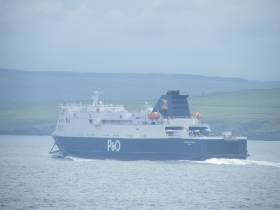Displaying items by tag: Highest freight volumes
#FerryNews - The highest volume of freight traffic in six years was carried on P&O Ferries Larne-Cairnryan service during 2017.
The ferry and logistics company, which operates between Northern Ireland and Scotland, carried 210,533 lorries and trailers on its ships during the last 12 months. The figure represents a 1.3 per cent increase on 2016 and is the best result since 2011.
P&O Ferries operates seven sailings a day between Larne and Cairnryan. The service on the North Channel is operated by the 22,000 ton sister ships European Highlander and European Causeway. The pair provide a bridge for goods being transported between Northern Ireland and the Republic of Ireland and Britain, and also on to the continent via P&O Ferries' connecting services from Dover, Tilbury, Hull and Teesport.
Neal Mernock, P&O Ferries' Sector Director for the Irish Sea, said: "These outstanding volumes illustrate the vital importance of our service to the thousands of businesses and millions of consumers who rely on the efficient and reliable transportation of goods across the Irish Sea."
"Larne is fast establishing itself as the gateway of choice for anyone exporting to or from Ireland, thanks to its outstanding connectivity via road and rail, and also the fact that it is nine miles closer to Scotland than the port at Belfast."
"The reliability of our service was exemplified in the spring when we brought one of our English Channel ferries, European Seaway, to cover the route while the other two ships went into dry dock for annual maintenance. The feedback from our customers was that they hadn't noticed any difference, which is the ultimate compliment."
In 2017 P&O Ferries saw strong volumes of agricultural and dairy produce, building materials, consumer goods, machinery, peat and household coal being transported on its two Irish Sea crossings, Larne-Cairnryan and Dublin-Liverpool, see Afloat's related coverage.
P&O Ferries is a leading pan-European ferry and logistics company, sailing 27,000 times a year on eight major routes between Britain, France, Northern Ireland, the Republic of Ireland, The Netherlands and Belgium. It operates more than 20 vessels which carry 10 million passengers and 2.2 million freight units annually.
Together with its logistics division, P&O Ferrymasters, the company also operates integrated road and rail links to countries across the continent including Italy, Poland, Germany, Spain and Romania. P&O Ferrymasters also owns a rail terminal in the Romanian city of Oradea, which facilitates the onward movement of goods to Britain from Asian countries via the Silk Road.
Afloat adds the operator is also examining opening a North Sea service linking Scotland and Scandinavia.
P&O Handle Highest Freight Volumes on North Channel Service Since 2011
#FreightVolumes - Operator P&O Ferries has announced that it handled the highest volume of freight in five years on its Larne-Cairnryan service in 2016.
The ferry and logistics company's route on the North Channel linking Northern Ireland and Scotland handled 206,700 freight units on the route during the last 12 months. This figure represents a 7.5 per cent increase on the previous year (192,200 units).
In a further indicator of the reliability of P&O Ferries' service, 2016 was the first ever year in which none of the 4,774 sailings scheduled from the port of Larne was cancelled, with 97 per cent of departures within ten minutes of their published time.
P&O Ferries operates seven sailings a day between Larne and Cairnryan in Scotland, a two hour service which is the shortest crossing of any operator on the North Channel. The regular daily service provides a bridge for goods being transported between Northern Ireland and the Republic of Ireland and Britain, and also on to the continent via its connecting services from Dover, Tilbury, Hull and Teesport.
Neal Mernock, P&O Ferries' Director responsible for the Irish Sea, said: "This highly encouraging performance shows that the economy of Northern Ireland is continuing to grow, notwithstanding the uncertainty heralded by the Brexit vote in June. We invested £500,000 last year in our two purpose built ferries on the route, the European Highlander and European Causeway, to upgrade facilities and passenger areas on the ships. This has already paid a dividend in terms of increasing customer satisfaction with our services."
"The frequency of sailings, short crossings, excellent reliability and the fact that the port is now only 30 minutes from Belfast by road via the newly built A2 are increasingly making Larne the gateway of choice for anyone exporting to or from Northern Ireland. We have seen particularly strong volumes of agricultural and dairy produce, household and stores goods, building materials and machinery."
























































